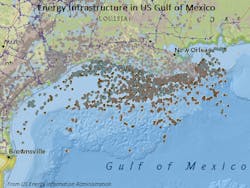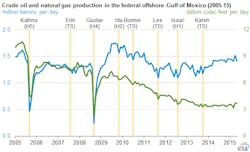A relatively light hurricane season anticipated for 2015 and an overall decline in the Gulf of Mexico’s share of US crude oil and natural gas production both serve to minimize the risk of supply disruptions, the US Energy Information Administration noted in its Aug. 28 energy update.
EIA explained that offshore energy output from the gulf “has experienced relatively minor disruptions because of tropical storms and hurricanes in recent years,” adding that the National Oceanic and Atmospheric Administration expects a below-normal 2015 hurricane season.
In 2003, 27% of the nation’s oil was produced in the gulf. By 2014, that share had declined to 16%. EIA earlier in the year projected crude output would reach 1.52 million b/d in 2015 and 1.61 million b/d in 2016—or respectively 16% and 17% of total US crude production during each year (OGJ Online, Mar. 3, 2015).
The gulf’s share of gas production also declined from a high of 26% in 1997 to merely 5% in 2014.
Based on NOAA’s outlook, EIA estimated in its June Short-Term Energy Outlook that storm-related disruptions in the gulf during the this hurricane season would total 9.7 million bbl of crude and 15.9 bcf of gas—or 3.5% and 2.8% of total gulf oil and gas production, respectively.
EIA projected a 14% probability that production during the current hurricane season will be unaffected. No production was affected during last year’s season.
As for the Gulf Coast region, where about half of US refining capacity and several gas processing and distribution facilities reside, EIA noted that high levels of crude inventories—both domestically and globally—could mitigate the supply impacts of weather-related disruptions, and gas processing capacity has been added in areas beyond the Gulf Coast in recent years.


